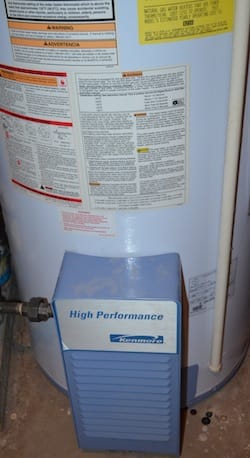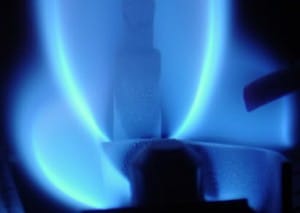 “There’s no hot water!” shouted my startled wife from the shower. A sudden grip of “fear” paralyzed me for a couple of seconds as I started to compute the age of our water heater aloud. It has to be around 12-13 years old. As reality set in, I realized that I was going to be in the market for a new water heater sooner or later
“There’s no hot water!” shouted my startled wife from the shower. A sudden grip of “fear” paralyzed me for a couple of seconds as I started to compute the age of our water heater aloud. It has to be around 12-13 years old. As reality set in, I realized that I was going to be in the market for a new water heater sooner or later
I took my handy flashlight and went to the basement mechanical room to take a look. The first thing I noticed upon my examination was that the pilot was off. After reading the instructions on lighting the pilot, I went through the steps carefully and popped that sucker back on, and lo and behold, the burner fired and we were back in business.
 My chest proudly out, I went back upstairs and informed my wife that I had performed my “manly” duty and got the water heater to work again. Score one for me. Listen, I know this is not a big deal, but believe me, it’s kind of a big deal. I went to sleep that night one happy dude, knowing crisis averted.
My chest proudly out, I went back upstairs and informed my wife that I had performed my “manly” duty and got the water heater to work again. Score one for me. Listen, I know this is not a big deal, but believe me, it’s kind of a big deal. I went to sleep that night one happy dude, knowing crisis averted.
But my glory was short lived as the very next morning I was awakened to: “Dad, guess what? No hot water again,” my son yelled upstairs. Crap.
I went back downstairs and noticed that the pilot was off, again.
I got on the phone with some of my contractor friends and the unanimous hypothesis—without seeing the unit themselves—was that the water heater needed a new thermocouple. Off I went to the local big box in search of a universal thermocouple. After a successful search, I returned home to do something I was very hesitant to do myself. Standing in the basement, I stared at the new thermocouple, then the water heater, then the thermocouple, fueling more doubt in my DIY ambitions.
I decided to call my local plumber to have him take a look. He came out that afternoon. He took the controls, gas valve and thermocouple apart and he slid the burner out from under the heater. He examined the components and informed me that everything looked okay, but he couldn’t put the new thermocouple in because the unit—a Kenmore 50-gallon water heater—employed a fuseable thermocouple so he recommended replacing it with the manufacturer’s parts.

But, “I can clean off the ends of the thermocouple; sometimes they get corroded,” he said. Sure go ahead, let’s see what happens. He cleaned off the ends, lit the pilot right away and the burner fired. He checked it again and again, turning the pilot off and on. He told me that the unit was working and venting properly. Success.
Upon leaving, “Keep me updated on what happens,” he said.
This little project had now become an obsession, and I was determined to see it through to its successful ending. I went back downstairs and ran hot water out of the utility sink until the burner was forced to turn back on, and it didn’t. I went through the process once again—lit the pilot, fired the burner, and watched. And waited. After the burner cycled through to heat the water to temp, POP!, the burner went out, and the pilot went off. Thus the problem. Every time the burner turned off, the pilot went out.
 I immediately called my contractor and he said that it could be the gas valve, and he could come back a replace it, “but do you want to go through the work and expense on 12-year-old water heater?”
I immediately called my contractor and he said that it could be the gas valve, and he could come back a replace it, “but do you want to go through the work and expense on 12-year-old water heater?”
“How much would it cost to replace and install a new 50-gallon water heater?” I asked.
“I install only Bradford White. For the unit, installation, labor and removal of the old one—about $900,” he said.
Whoa. That grip of fear paralyzed me again, and then reality, “I’ll discuss with the wife and get back to you.”
Something wasn’t adding up: the pilot was lighting, the burner firing and the water heater heating and delivering. Befuddled, I Googled “troubleshooting Kenmore water heaters” and I came across a YouTube video of a disgruntled Kenmore owner who had spent countless hours and money replacing valves and thermocouples, to no avail. A long shot for sure, he said that in his experience, if you clean the filters, located at the very bottom of the unit, it allows air to enter into the combustion area, allowing the pilot to remain lit.
Finding a long-handled brush, I turned off the unit, and proceeded to brush the bottom vent. I could see a collection of dust and hair fly off the vent, a good amount collecting on the brush’s end.
Putting all the pieces together and turning the water heater back on, I lit the pilot, fired the burner, waited for the unit to reach temperature. And I waited. Waited until that infamous POP!, and the burner turned off. But this time the pilot stayed lit, and it has stayed lit, I’m happy to report.
Later that night I was relishing in my victory, so to speak, with friends, when one of them asked me if my plumber knew all along the ol’ clean the filter trick but purposely didn’t tell me in the hopes of trying to get me to spend big money on the water heater changeout.
Absolutely not. Let me repeat this, absolutely not. It never occurred to me that my contractor was trying to deceive me; he was just trying to do what he thought was the best solution for the situation.
It’s time we start trusting our service providers — in the work they do, and the amount they charge. There was a recent expose on Dateline NBC, which called out a few shady HVAC workers and gave the industry a “black eye,” but by all means the whole is greater than the sum of its very few parts.
In my opinion, there is no more helpless feeling than being in a flooded basement, standing in your own poop. Or having the heat go out on the coldest day of the year or, on the flipside, the air going out on the hottest day of the year. And by all means I did not want to have a water heater mishap where my body ends up in the front yard of a home three blocks down.
What to do when an unexpected plumbing or heating problem occurs? Call your trusted, certified contractor to do the work, and thank them when they leave. Simple as that.




Join the conversation: